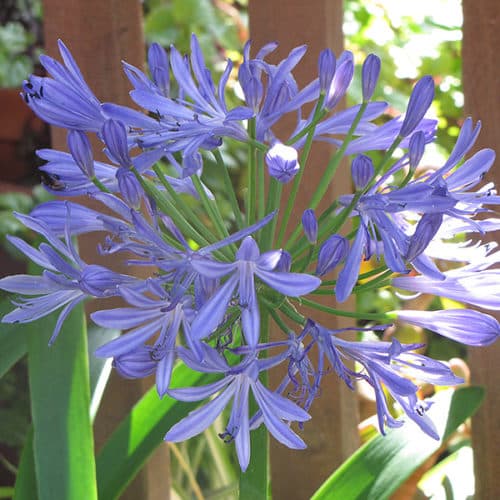Agapanthus Companion Plant Kingdoms: Perfect Pairings for Your Yard
Agapanthus Companion Plant Kingdoms: Perfect Pairings for Your Yard
Blog Article
Releasing the Secret to Successful Agapanthus Growing: Advice for a Flourishing Yard
In the realm of gardening, cultivating agapanthus successfully calls for a critical approach that includes various aspects of plant treatment. By comprehending the subtleties of agapanthus growing, one can develop a setting where these plants thrive and flower perfectly.
Planting Agapanthus: Best Practices
When planting Agapanthus, proper dirt preparation is necessary for making certain successful development and growth of these beautiful flowers. Agapanthus, frequently called Lily of the Nile or African lily, grows in well-draining soil with a somewhat acidic to neutral pH level - Agapanthus. Before planting, it is critical to change hefty clay dirts with raw material such as compost or peat moss to boost water drainage and give necessary nutrients for the plants
To grow Agapanthus, select a place that receives full sunlight to partial shade, as this will advertise healthy and balanced development and bountiful flowering. Dig an opening two times the size of the plant's origin ball and position the Agapanthus at the same deepness it was formerly growing. Carefully backfill the hole with soil, weighing down strongly to get rid of any air pockets around the origins.
Water the newly planted Agapanthus completely and continue to keep the dirt evenly moist, particularly during the plant's active growing season. Agapanthus. Using a well balanced fertilizer once a month can even more support the plant's growth and blooming. By following these ideal techniques for planting Agapanthus, you can develop a magnificent display screen of these exciting blossoms in your yard
Suitable Soil Issues for Agapanthus
For optimum growth and blooming success of Agapanthus plants, ensuring the dirt conditions are ideal is crucial. Agapanthus flourishes in well-draining dirt with a slightly acidic to neutral pH level varying from 6.0 to 7.0. This sort of dirt allows for sufficient water drainage, protecting against waterlogging which can cause root rot. To improve dirt drain, take into consideration adding raw material such as compost or peat moss when preparing the growing site. In addition, Agapanthus likes dirt that is rich in nutrients, so including a balanced plant food during the growing period can promote healthy and balanced development and lively flowers.

Watering and Feeding Tips
To make sure healthy and balanced growth and dynamic blossoms, correct watering and feeding techniques are essential for effective Agapanthus growing. Agapanthus plants take advantage of regular watering, especially during the growing period. It is advised to water deeply as soon as a week, ensuring the dirt is wet however not soaked. During hot weather or in pots, more constant watering might be essential to stop the soil from drying entirely.
When it comes to feeding Agapanthus, a well balanced fertilizer with equal components nitrogen, phosphorus, and potassium can be used in the spring to promote healthy Your Domain Name and balanced growth and blooming. Slow-release plant foods are excellent for giving nutrients slowly over an extended period. Stay clear of over-fertilizing, as this can cause extreme vegetation growth at the expenditure of flowers.
Additionally, integrating organic issue like compost into the dirt can boost nutrient levels and boost soil structure, helping in the total health and wellness of the Agapanthus plants. By adhering to these watering and fertilizing pointers, gardeners can guarantee their Agapanthus plants thrive and create stunning screens of blossoms.
Pruning and Deadheading Techniques
Correct pruning and deadheading strategies play a vital role in keeping the health and aesthetics of Agapanthus plants, matching the crucial practices of watering and feeding for effective cultivation. Pruning Agapanthus includes getting rid of invested flower heads, yellowing or dead fallen leaves, and total shaping of the plant to promote better growth. Deadheading, the Discover More process of eliminating discolored blossoms, not only improves the plant's look but likewise urges further flowering.
When deadheading Agapanthus, it is advisable to clip off the blossom stem at the base using sharp, clean shears. This process redirects the plant's energy from seed production back into root and foliage growth, advertising a much healthier and more robust plant. Normal deadheading can extend the blooming period of Agapanthus and protect against self-seeding, which can lead to overcrowding.
In regards to pruning, Agapanthus typically advantages from a light trim after blooming to clean the plant and encourage fresh growth. Reducing back the invested blossom stems and getting rid of any type of dead or broken vegetation helps maintain the plant's vitality and total look. Nevertheless, it is vital to prevent reducing right into the crown of the plant, as this can deteriorate its health and wellness.

Protecting Agapanthus From Vermins and Diseases
Implementing efficient pest and disease monitoring techniques is crucial to securing the health and wellness and vitality of Agapanthus plants in growing. One usual pest that influences Agapanthus is the Agapanthus borer, a caterpillar that tunnels right into the plant, causing damage to the fallen leaves and flowers.
In addition to insects, find more info Agapanthus are prone to illness such as origin rot and fungal fallen leave spots. By staying watchful and dealing with insect and disease issues immediately, gardeners can help their Agapanthus prosper and grow.

Conclusion
Finally, successful farming of agapanthus requires proper growing methods, perfect dirt problems, adequate watering and feeding, routine trimming and deadheading, and security from conditions and parasites. By adhering to these methods and tips, garden enthusiasts can make sure a flourishing garden full of stunning agapanthus blossoms. Agapanthus. Keep in mind to preserve regular care and interest to detail to promote the wellness and longevity of these sensational plants
When planting Agapanthus, proper soil prep work is important for making sure successful growth and growth of these beautiful flowers.Water the freshly grown Agapanthus completely and proceed to keep the soil evenly moist, especially during the plant's energetic expanding period.For optimal growth and flowering success of Agapanthus plants, ensuring the dirt conditions are perfect is critical. When hair transplanting or growing Agapanthus, ensure the soil is well-prepared to give the needed foundation for the plants to establish themselves effectively. One common pest that affects Agapanthus is the Agapanthus borer, a caterpillar that tunnels right into the plant, causing damages to the leaves and blossoms.
Report this page